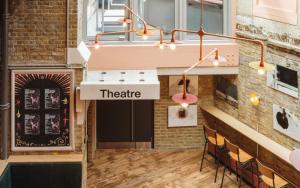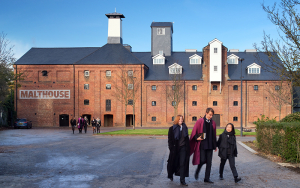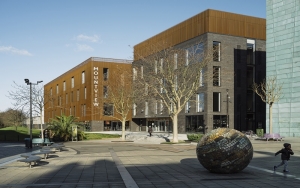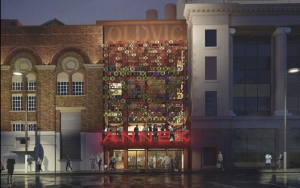Hoxton Hall
Hoxton Hall is a Grade II*-listed and very rare surviving Victorian music hall located on bustling Hoxton Street in East London. The building is used as a community arts centre.
Jacksons Lane Arts Centre
Founded in 1975 inside a former Wesleyan Methodist church, Grade II-listed Jacksons Lane Arts Centre has played a key role in the development of London’s fringe and community theatre. The latest project upgrades technical and visitor facilities within the complex, which features a 166-capacity theatre, large-scale studio and café-bar, all of which were in need of repair.
Jerwood Gallery (Hastings Contemporary)
Award-winning new-build for the Jerwood Foundation
A new gallery and restaurant, built in a challenging site on the seafront in Hastings. It incorporates an innovative ground-source heating and cooling system, enabling the building to achieve impressively low emissions for a structure of its kind.
Jerwood Gallery, located in Hastings, East Sussex, is dedicated to contemporary British art and operated by the Jerwood Foundation, a privately funded charity. The new build gallery is part of a wider masterplan to transform a former coach and lorry park on a key seafront site in Hastings Old Town.
Sustainability was central to the design, influencing orientation, layout, materials, and servicing. The galleries maximise natural daylight and ventilation, creating a pleasant and well-lit environment for visitors whilst minimising energy consumption.
Below-ground ducts ensure a seamless design, maintaining floor-to-ceiling levels and concealing services. Solar panels provide most hot water, and rainwater is recycled to further lessen the environmental impact. A comprehensive analysis of renewable energy options, which included evaluating life cycle costs and ongoing maintenance was also undertaken.
To meet stringent temperature and humidity control standards, Skelly & Couch developed an innovative approach to preserve artifacts. The collection galleries utilise air conditioning powered by ground source cooling, with eleven 120-meter-deep probes handling all cooling and 60% of the heating, integrating geothermal energy for effective temperature regulation. This approach resulted in 60% less CO2 emissions compared to an average museum of similar size.
The Jerwood Gallery sets a new benchmark for environmental performance in museum design. It combines energy efficiency with precise climate control, while creating a welcoming space that enhances the overall visitor experience. The project achieved an ‘Exemplar’ rating at design stage using an industry standard Sustainability rating tool.
King's School Canterbury Collection
A series of commissions for The King’s School Canterbury £48m plan.
As part of The King’s School Canterbury £48 million development plan, five projects have been undertaken: the Malthouse Performing Arts Centre, Kingsdown House, Mitchinson’s Day House, an International College, and the Precincts project with the Rausing Science Centre and additional dining facilities—all in collaboration with Skelly & Couch.
The 19th-century Malthouse is a new performance centre for the school, comprising drama and dance teaching facilities, a 350-seat auditorium, theatre foyers, as well as science and art teaching accommodation. It also includes commercial kitchen and dining facilities.
Phase 1 of the Kingsdown House refurbishment created boarding accommodation for 30 pupils, including a common room, study area, and kitchen. For phase 2, a new building was constructed for the older pupils of the house. Kingsdown House won three 2019 Canterbury Society Design Awards and a 2018 Civic Trust AABC Conservation Commendation.
The masterful conversion of a Grade II-listed building provided the Mitchinson’s Day House for 70 non-boarding pupils, featuring study and social spaces, changing rooms, and a kitchenette; ensuring high levels of comfort while minimising operational energy consumption through passive design.
The International College is a purpose-built teaching and residential building designed for international students to live and learn in Canterbury. It offers 34 ensuite bedrooms for students, as well as flats for staff and specialist teaching facilities. Constructed in cross-laminated timber, the three-storey building wraps around a private courtyard for socialising and learning.
Resolving two main challenges on the school’s site, the Precincts Project has updated and co-located science facilities to bring them up to a world-class standard and increased dining and social provision to cater for a larger school population.
The Rausing Science Centre is the school’s first new construction since the 1970s. Situated within a World Heritage Site with a rich archaeological history and Grade I-listed buildings, the centre was meticulously designed to blend with its environment. It features six state-of-the-art physics labs, a versatile auditorium for up to 140 people, and dedicated spaces for staff and circulation. it connects with refurbished biology and chemistry facilities, fostering interdisciplinary collaboration.
Lastly, the ground floor of the Grade II listed Shirley hall has been reconfigured to create a second lunchtime venue, providing additional space for students to enjoy meals in a historic and scenic setting.
The developments at King’s School, Canterbury bring the UK’s most historic school to a world-class standard by meeting the educational needs of today while respecting the architectural legacy of the past.
Awards
Winner of a RIBA National Award 2021.
Winner of three RIBA South East Awards 2021: Main Award, Building of the Year and Conservation
Civic Trust Awards 2023.
Winner of an AJ Retrofit Award 2021: Cultural Buildings £5 million and over.
Winner of three Canterbury Society Design Awards 2019: Overall Winner; New Building in a Conservation Area; and best Refurbishment.
Commended at the Civic Trust AABC Conservation 2018.
Shortlisted for an AJ Retrofit Award 2019.
Winner of a RIBA National Award 2021.
Highly Commended at the in the Civic Trust Awards 2022.
King's School Canterbury – Malthouse
A modern performance centre developed within a historic maltings.
A former maltings now hosts drama and dance studios, a 350-seat theatre encouraging pupil involvement both on and off stage. Foyers, carved out from historic barley kilns, connect to a commercial kitchen, dining rooms, science labs, and art studios. Additional spaces include drama department offices, actor changing rooms, and set production workshops.
The King’s School Canterbury is Britain’s oldest public school, a co-educational day and boarding school. Our long-standing professional relationship with the school has resulted in bespoke standard project specifications, simplifying maintenance, and establishing common design standards for future endeavours.
The sensitive repurposing of the 19th century Malt into a new performance centre involved threading services around existing building features, requiring close collaboration with the whole design team, whilst meeting the client’s brief for facilities akin to those found in professional theatre environments.
Significant upgrades to the fabric and insulation resulted in a largely-reused existing building with great sustainability credentials. Secondary glazing was added to improve efficiency whilst retaining the historic windows and a careful analysis determined which parts of the building could be comfortably naturally ventilated, despite it being immediately beside both the train line into London and residential properties.
Where natural ventilation was not appropriate, heat recovery systems were designed to ensure efficient use of energy in operation. Full M&E services were designed to ensure energy-efficient operation and lower carbon emissions.
Winning a RIBA National and four East Awards in 2021, the Malthouse at King’s School Canterbury was praised as an "exemplar of how to repurpose an existing building in an imaginative, honest, and sensitive way." This recognition highlights the successful transformation of the maltings, now a centre for creating and experiencing drama and dance of the highest quality.
Awards
Winner of a RIBA National Award 2021.
Winner of three RIBA South East Awards 2021: main award, Building of the Year and Conservation - Full Article.
Civic Trust Awards 2023.
Winner of an AJ Retrofit Award 2021: Cultural Buildings £5 million and over. The conversion of the Victorian brewery maltings into a school theatre and drama centre was described by judges as combining ‘a freshness of approach while sensitively retaining the character of the existing building’.
Mountview Academy of Theatre Arts
Skelly & Couch worked on a spectacular new home for the Mountview Academy of Theatre Arts on a site behind the Stirling Prize-winning Peckham Library in south London.
National Theatre Costume Workshops
Refurbished, purpose-built facilities for a sustainable theatre production.
Enhancements to the wig, hair and make-up studios, dye rooms, prop workshops and laundry rooms, including replacement of gas fired tumble dryers and dye vats with electric alternatives and improving heating, cooling, lighting and controls to support the Theatre’s goal of achieving net-zero carbon by 2030.
Respecting the Theatre’s Grade II* listing, Skelly and Couch provided facilities tailored to the unique nature of the work. Liaising with the local authority was vital to preserving the building's heritage, while working with dye vat and fume extract specialists ensured the facilities met specific operational needs.
Boasting over 80 square meters of glazing, the existing structure utilises a large light well to naturally illuminate the spaces. Thermal modelling was imperative to ensured this expansive façade was not overheating the studios. Furthermore, building fabric and insulation options were explored to reduce heat loss during the winter months.
The theatre has made strides in reducing its energy consumption through the installation of heat recovery in the ventilation system and upgrades to heating and lighting controls, which have allowed staff to better moderate the internal environment. Additionally, the existing heating system was replaced with an electric alternative, future-proofed for compatibility with a heat pump to support the NT's ongoing progress.
Skelly and Couch used precise phasing and conducted noise testing of existing areas to limit disruption and allow performances to continue, where applicable, attenuators and spring mounted fans were fitted.
To minimise the presence of dust and fumes in the workshops, different vent and ventilation strategies were assessed through BIM modelling, and existing specialist extract equipment was evaluated including an analysis of air movement at user face height and measurements of air velocity. These practices, accompanied by the installation of emergency safety features helped promote employee welfare.
Following this project, Skelly and Couch have continued to work closely with the National Theatre, developing crew facilities and the new NT Green Stores, refurbishing the Dorfman theatre, and undertaking extensive reroofing and rewiring works.
New Temple Complex
The 559m² New Temple Complex by James Gorst Architects demonstrates an exemplar approach to passive design and long-term sustainability.
Situated within an 11.5-hectare estate in the South Downs National Park, the New Temple Complex is a multi-faith space comprising of healing chapels, a library, a multi-use lecture room, a kitchen and a visitor’s entrance foyer; all linked via an internal cloister. The temple holds symbolic elements reflecting the spiritual beliefs of the White Eagle Lodge and it occupies the same sacred spot as its 1970s predecessor. The building is completely framed in timber with clay brickwork encased in chalk lime mortar, all natural materials found in the immediate surroundings, encouraging a connection with the landscape.
The building’s environmental strategy is rooted in passive design principles, prioritising energy efficiency during the initial design phase. This approach includes low fabric heat loss, enhanced daylighting, and natural ventilation, forming the basis for the subsequent integration of low-carbon and renewable technologies.
The building fabric incorporates high-performance glazing exceeding conventional insulation standards, thereby effectively minimising heat loss. The New Temple's shallow, single-storey structure maximises daylight, reducing the need for artificial lighting. Nestled away from noise and pollution, the temple enjoys the benefits of natural ventilation, further aided by high-level actuators strategically placed in the temple's clerestory.
Innovative sustainability features include a sub-floor ventilation system operational in high occupancy areas. This system uses the thermal mass of a labyrinth to provide tempered air in winter and free cooling in summer.
Overcoming challenges posed by the absence of natural gas infrastructure and the availability of only single-phase power, the project successfully procured a small low-carbon ground source heat pump meeting the needs of the entire building. Buried in the landscape, this technology extracts low-temperature energy from the ground, producing higher temperatures that serve underfloor heating throughout the temple. Pre-existing photovoltaic panels were repurposed and relocated to an open area on-site, partially powering the heat pump and providing the building with low-carbon electricity.
The New Temple Complex stands as a timeless space for contemplation and community, seamlessly blending spirituality, simple architecture, and sustainable design. Its harmonious integration with the surroundings embodies both peace and environmental stewardship.
In Numbers
On-site energy generation 4,550 kWh/yr
Heating and hot water load 19.73 kWh/m2/yr
Total energy load 42.60 kWh/m2/yr
Carbon emissions (all) 25.9 kgCO2/m2
Services
Electrical and Lighting
Heating
Ventilation
Acoustics
Awards
RIBA National Award 2024
RIBA South Awards – South Award Winner 2024
RIBA South Awards – Building of the Year Winner 2024
RIBA South Awards – Sustainability Award Winner 2024
RIBA South Awards – Project Architect of the Year Winner 2024
Civic Trust Awards – The National Panel Special Award Winner 2024
Civic Trust Awards – The Special Award for Sustainability 2024
AJ Architecture Awards – Winners 2023
Wood Awards – Winners 2023
Download press coverage from right-hand column.
Oily Cart Theatre
The home of the touring theatre company for young people with complex disabilities, Oily Cart, is located within the Annexe of a Grade II-listed school in South London (Smallwood School) and recently underwent a refurbishment, with a large part of the existing building fabric retained.
Old Vic Annex
A new annex for Grade II*-listed theatre and the redevelopment of its back of house
A new-build six-storey extension and major reworking of the back of house to the world-famous Grade II*-listed theatre in London’s Waterloo. Highlights include an innovative natural ventilation system facilitated by thermal modelling. Rated BREEAM Excellent.
The Old Vic Theatre is located on Waterloo Road in London. New back-of-house facilities will be situated next to the theatre, replacing a former commercial restaurant. The project aims to meet the client’s budget while delivering a bespoke, highly sustainable solution through excellent design and construction standards. The new annex will feature a triple-height street café, script library, writers' room, learning centre, green room, and rooftop event space.
The site remains comfortable in summer due to passive strategies such as thermal mass, secure nighttime cooling, shading, and natural ventilation.
Key project features include a natural ventilation system that mitigates noise and pollution from the busy road, using a fully sealed front façade. To compensate for the timber structure’s limited thermal mass, the system draws air from the top of the stairwell, cooling it via the staircase's thermal mass. In warm weather, the cooled air flows into lower areas and rises to exit through a solar chimney. The process is driven by heat from occupants and solar gain through the glazed front façade as well as carefully detailed roof cowls to maximise the cooling benefit of the prevailing wind. Stairwell glazing at each floor enhances daylight and visual connectivity.
A low-temperature hot water system, including domestic hot water, is powered by rooftop air-source heat pumps.
The project has also remodelled the existing back-of-house areas with a relocation of the stage door, improved dressing room and office facilities and a rooftop air handling unit (AHU) supplying fresh, tempered air to the rehearsal room, supplied via an air source heat pump.
The Old Vic Theatre sets a new standard for sustainable design in historic buildings by implementing innovative passive strategies along with energy-efficient systems, creating an enhanced environment for performers and visitors alike and securing its legacy for generations to come.














